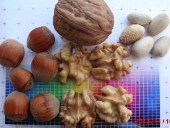It's definitely possible to grow walnuts from cuttings, it's just not that easy compared to many other plants and allegedly they grow much weaker roots compared to those grown from seed. In commercial orchards they usually graft specific walnut varieties on rootstocks grown from seed of a particular variety that has good properties when grown from seed, but from what I've heard cloning particular rootstocks with cuttings also takes place in some areas. I guess if you prune the tree in a certain way you can keep it on the smaller end and it would still do fine if not put into too much of an exposed location.
You don't actually have to stratify walnuts it seems, if you just soak them for 24-48 hours and gently crack the shell around the pointy end where the germ is they will quickly grow into trees within just a few weeks of planting. I did it just like in this video I will link down below and have so far had 100% success rate when it came to germination, growing roots etc indoors. Sadly several of the very few nuts of a particular local, extra hardy tree that I had were destroyed by millipedes and fungus gnat larvae in the soil before I realized what was going on. If you keep them outdoors in the shell over winter that will help to protect them while they germinate and they will come up as seedlings in the spring ready to grow for the entire season, natural predators in the soil will also help keeping insect pests away I guess. But if you plant them outdoors you need to seriously protect them against squirrels, mice, other rodents and birds because they love digging walnuts up and other nut seeds to eat them otherwise!
Check this video out to see a very easy and simple way of making walnuts germinate:
https://www.youtube.com/watch?v=-nPNd269q1I
I did just like in the video but took my nuts out after 11-12 days to gently crack them open in the pointy end and saw that they had all already germinated, I probably didn't even need the fridge step. I got seedlings in less than a month from the moment I picked fresh seeds up from the ground. It definitely works. As for cracking the nut shell without destroying the inner nut/seed/germ I recommend gently tapping the pointy end with a hand sledge or hammer until you crack the pointy end open, do not use excessive force and just let the weight of the hammer/hand sledge crack it open for you, that will definitely not harm the inner seed. There's no need to pry off the shell of the entire inner seed, there's a high risk of destroying the entire seed and splitting it in the half if you do that. I think a light soil-less medium like perlite, sand etc might a good idea for letting the walnuts sprout in peace free of any insect pests or mold and damp off. There is so much energy and nutrients already stored inside the nut seed that it won't need nutrients from the soil for some time while it grows into a seedling that you can transplant later when it's ready.

 2
2




![Filename: leafscar.jpg
Description: [Thumbnail for leafscar.jpg]](/t/163774/a/147446/leafscar.jpg)
 1
1





 1
1





 6
6


































 1
1











 3
3




 5
5












 1
1








 1
1












